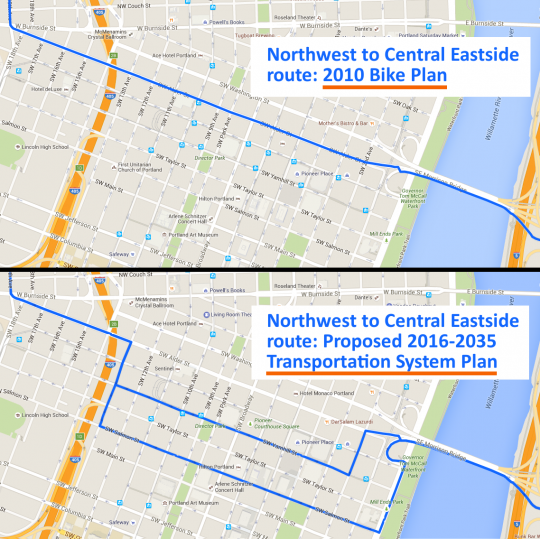
The city says there’s no room for future bike lanes on the most direct street between Northwest Portland’s fast-growing residential area and the Central Eastside’s fast-growing job district.
Instead, inner Southwest Alder Street is slated to become a “trafficway” offering automobile and truck connections to the Morrison Bridge and interstate highways.
Alder might also get a bus line, the city says.
Today, Alder has a parking lane on each side and two lanes of mixed eastbound traffic. At many of its corners, traffic signal poles sit in the curb extensions, making it quite expensive to pull those extensions back to make room for bike lanes.
But as we mentioned in an article last week, Alder also offers a straight shot from the bikeways on Northwest 18th/19th to the underused bikeway on the Morrison Bridge:
Here’s a look at the central city biking network envisioned last year in the city’s West Quadrant Plan:
But Morrison Street, though it is marked here as a bikeway, “would have to be a shared street” for both cars and bikes, city spokesman John Brady said Friday.
Alder’s convenient link between the two neighborhoods — the Northwest teens and 20s have 1,000 new residential units in recent or upcoming development, and the Central Eastside has added hundreds of jobs in the last decade — has caught the attention of some biking advocates. Here’s Iain Mackenzie of NextPortland in a comment on last week’s post:
A bidirectional protected bike lane on Alder would be fantastic. It could change the Morrison Bridge MUP from being one of the least used crossings of the river into one of the most used. On the West side the City is already looking at ways to better connect the NW 18th and 19th bike lanes to SW Alder. On the East Side the City is planning a Morrison-Belmont bikeway couplet, including using the roadway under the viaducts and making SE Morrison between Grand and 12th one way in order to add a bike lane. All these projects together would not only connect Northwest to the Central Eastside, as mentioned above, but would also provide a great new connection from inner SE into Downtown.
All of which is by way of saying that it’s very odd that in the Transportation System Plan section of the draft Central City 2035 plan (published yesterday) it is proposed to remove the “City Bikeway” designation from SW Alder between 2nd and 12th.
Advertisement
We thought that was odd too, so we asked the city about it. Spokesman John Brady’s response was prompt and thorough. The answer is that the city is proposing to jog part of the future Alder bikeway three blocks further south.
On Alder in particular, lane capacity is needed to serve motor vehicle traffic leading up to the Morrison Bridge.”
— PBOT
That’d create a six-block gap between the Oak/Stark and Salmon/Taylor bike lane couplets. However, people would also have the option of shortening this route by sharing the lane with cars on the Morrison/Yamhill couplet. My emphasis added:
The proposed street classification updates for the downtown portion of Central City 2035 are in large part reflective of the concept maps that were included in the adopted West Quadrant Plan. Those concept maps attempted to outline a more clear set of emphasized modes for each street, recognizing that with narrow right-of-ways in the Central City, we will not always be able to emphasize all modes equally. At the same time, we made every effort to respect the intent of the Bicycle Plan for 2030 to create a comprehensive network of bikeways in the Central City.
The West Quadrant Plan shows Alder and Washington from the Morrison Bridge to Broadway as “Freight & Motor Vehicle” streets. On Alder in particular, lane capacity is needed to serve motor vehicle traffic leading up to the Morrison Bridge, and freight loading zones are needed to serve retail uses along the street. Though Alder is not shown as a Transitway on the Transit map in the West Quadrant Plan, there is interest in introducing bus service to Alder in the future. We have proposed switching the Transit Access Street designation from Salmon to Alder to reflect the City’s interest in switching bus service from Salmon to Alder so that Salmon can more easily serve a City Bikeway function. In short, the proposal is that from roughly SW 2nd Ave to SW 12th Ave, Alder and Washington would emphasize Freight, Motor Vehicle, and Transit modes. West of 12th Ave, it would primarily emphasize the Bicycle and Transit modes.
The Bicycle concept map from the West Quadrant Plan shows Morrison and Salmon as a main bikeway couplet connecting the Morrison Bridge to SW 20th, with Alder as well from 18th to 12th to provide the necessary connection from the NW 18th/19th couplet. When PBOT staff considered this map, we recognized that a three-block-wide couplet may not be intuitive for bicycle travel, so our proposed classifications in the Central City 2035 Discussion Draft show Salmon, Taylor, Yamhill, and Morrison as City Bikeways. These two couplets would provide different experiences and may serve different rider types, since Salmon/Taylor would most likely be separated bike lanes whereas along the light rail lines on Yamhill/Morrison it would have to be shared street facilities.
With two parking lanes and two travel lanes, Alder is wide enough for two auto travel lanes (one of which could be a dedicated bus lane), plus a parking/loading lane on one side and a one-direction protected bike lane on the other. Or it could become a one-lane street for auto traffic with two parking lanes and a narrow bidirectional protected bike lane.
Another option would be for the city to convert the single auto lanes on Morrison and Yamhill to wide bike laness, a sort of east-west car-free transit mall.
Another option would be for the city to convert the single standard lanes on Morrison and Yamhill to wide bike-only lanes, a sort of east-west carfree transit mall. With one exception on Yamhill and 6th, inner Southwest Morrison/Yamhill are the rare downtown streets that don’t have a single parking garage or other curb cut facing them.
But despite its policy to generally prioritize public transit over auto traffic and bike traffic over both, the city isn’t planning to do any of those things.
Another option would be to improve Yamhill and Morrison for biking by adding one or more traffic diverters. This would reduce the number of cars on them without making them fully car-free. Except for its general neighborhood greenway standards, which arguably would require those diverters, the city hasn’t yet made explicit plans to do that, either.
The city is, however, encouraging people to submit comments on its Transportation System Plan through the end of this month.
“The easiest way to comment is to email cc2035@portlandoregon.gov,” Brady wrote on Friday. “City staff at BPS and PBOT will review public comments and revise the document to create the Proposed Draft in May 2016.”
It’s worth mentioning that there’s good news for biking in the city’s latest plans too. We’ll cover some of those in an upcoming post.
Update 2/16: We’ve added another route, on Yamhill, to the map at the top of this post to reflect the possibility that traffic diverters might make it function as an all-ages bikeway through downtown.
— Michael Andersen, (503) 333-7824 – michael@bikeportland.org
BikePortland can’t survive without paid subscribers. Please sign up today.


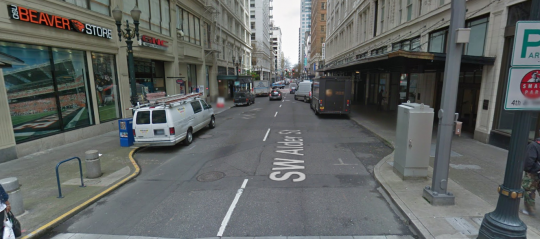
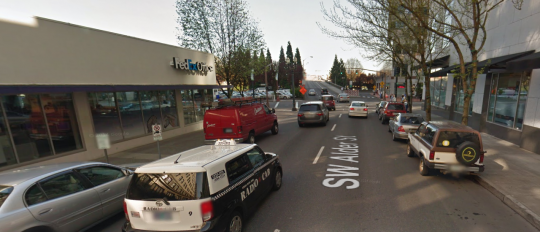
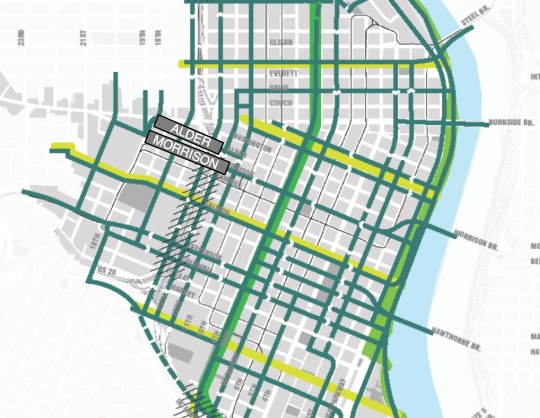
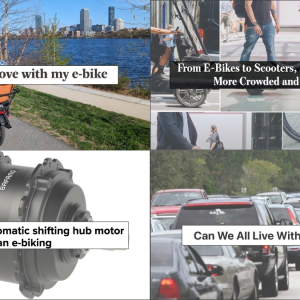

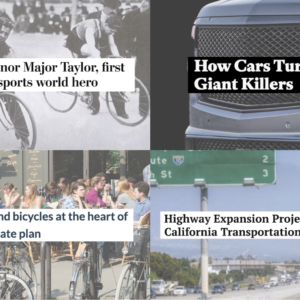
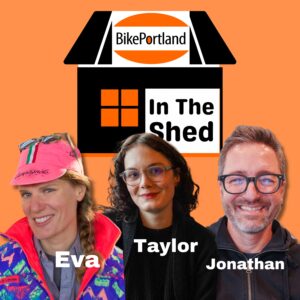
Thanks for reading.
BikePortland has served this community with independent community journalism since 2005. We rely on subscriptions from readers like you to survive. Your financial support is vital in keeping this valuable resource alive and well.
Please subscribe today to strengthen and expand our work.
Are they seriously proposing forcing cyclists to make three lefts to cross the Morrison? It would make much more sense to jog two blocks north at 12th and make use of the existing bikeway, then install a protected intersection at Third and Alder and a cycletrack for the last two blocks leading up to the bridge.
Or, how about Burnside loses a lane from Alder to Stark (I’m thinking maybe enough MVs split onto Alder that it could work for the city)?
Then there’s a dedicated bikeway on Burnside from 19th to Stark. The route from NW to Morrison bridge would be a straight shot: 19th, to Burnside, to Stark to [your proposal for the last bit].
I don’t hate the Stark-Salmon-Jefferson-Harrison spacing for bike routes, but that’s a really unintuitive route for 19th to Morrison Br.
Forgot to mention it could be in part done with the 18th/19th/Burnside intersection project
>(I’m thinking maybe enough MVs split onto Alder that it could work for the city)?
http://bikeportland.org/2014/10/10/less-500000-three-road-diets-preventing-37-crashes-every-year-112049#comment-5604167
If city policy is 800 vehicles per lane downtown then volume at 15th is too high.
I can understand that things change: plans made in good faith years ago, but never fulfilled, probably do need to be reexamined. The fact that they’re sticking to a general vision of full bike access throughout the Central City is good. For one thing, it’s the only way NIke-Bikey is going to take off.
But “the City says there’s no room” and (essentially) “we just can’t treat all modes equally so, here, have an unintuitive non-couplet” feels so discouraging.
Hello, PBOT? I won’t use bike routes that are indirect and confusing. I will continue to mix it up on the “traffic” streets, because I am traffic and I demand an equal level of convenience.
I’ll be right there with you. Safety in numbers!
…and I! I’ll be there too. This nonsense about “don’t have enough space” and circling us around a bunch of lanes is unacceptable nonsense.
That’s how I ride downtown also. Convenience is my first concern. None of the roads downtown are unsafe enough for me to try to follow a trail of little green signs.
In an area absolutely cluttered with signs so that the teeny weeny tiny bike guide signs will be darn near invisible.
Yes, and having ridden this route a fair amount over the last 4.5 years of living in the NW 20’s, I can say that you don’t have much traffic to contend with on Alder until about Broadway. Before that traffic is light and you have downhill speed to easily keep pace with vehicles. Below Broadway is more congested, but if you ride as a car in the lane it doesn’t feel stressful since there is little speed involved. Morrison is the bridge I feel safest riding across, and I used it a lot to go to bars, restaurants, the indoor soccer center or connect to the Springwater. I was always bummed there wasn’t a good westbound route if I wanted to use the bridge to head home. This is too bad, it’s always seemed like one of the best direct, hidden gem of a shortcut through downtown.
I will continue to use all lanes/all hours regardless of designations, including full lane use on Broadway due to persistent hazards in and around the bike lane. Markings or not, designations or not.
The Morrison Bridge has the best bike facility that goes nowhere. Unless you are going to OMSI or Hair of the Dog, it’s not a great connection to the east side. The Morrison is essentially a highway interchange on the east side, so I don’t even know how you’d squeeze in a protected cycleway there.
It’s probably just better to build cycle tracks further south to connect to the Hawthorne Bridge instead. The Jefferson/Columbia couplet would be a good starting point. Many people use those streets already to bike to the Goose Hollow MAX, which will only increase when TriMet completes the bike parking facility at that station. The bike lane on Jefferson is too narrow and in the door zone, while riding uphill on Columbia is harrowing without any cycling facilities and angry drivers behind you. They are only one block over from the Hawthorne Bridge, so an easy connection could be made there.
Morrison and Yamhill are already good for cycling, but would not make a good official route due to the challenge of making left turns across the tracks. A better plan would be to either ban driving on the crossmall or put in diverters every few blocks like the bus mall used to have.
I am not surprised by PBOT’s position on Alder. Their “unofficial” policy seems to be getting people cycling out of the way whenever possible. This is especially evident regarding bicycle access to business corridors, which in Portland is woefully inadequate. We need to work more towards complete streets rather than specific streets for cycling while still allowing motor traffic access to those “bicycle priority” streets anyway. Bicycle priority needs to mean exactly that: people driving are treated like guests – a few diverters here and there doesn’t cut it.
Yeas! Lets focus on routes to and from the Hawthorne and Burnside Bridges. The Morrison is only barely acceptable BECAUSE no one can get to it or uses it! If they made some solid connections to that bridge That skinny sidewalk on the south sidewalk would immediately be too small for peds and bikes. I say write-off the Morrison for now and concentrate on connections to bridges with actual potential.
I use all three of those streets today, but generally only use Alder to access destinations downtown. There’s no good westbound street to pair with Alder.
From NW if I’m going to the east side, I generally go to Naito and then take the water-level Steel Bridge path to the Esplanade rather than use the Morrison.
Are you “avoiding a traffic hazard” if you’re riding upstream on the sidewalk?
I also think Morrison and Yamhill are good for cycling, but they are terrible for turning out of or into because of the MAX tracks. Especially Yamhill where it is a pedestrian mall between 2nd and 3rd.
I am frustrated as well by being shuffled out of the way of commercial districts — I want to go to those stores too! And have parking and access for my vehicle. I’m not just riding my bike THROUGH an area — I’m often riding TO something and yet I can’t get there easily because I’ve been shunted off to the side.
I believe this is an inherent problem with putting most of our eggs in the greenway system: they are great (most of the time) for commuting or riding through, but by definition, they divert people cycling off the “main” routes that have all the destinations. With a few exceptions, someone cycling to a store, restaurant, or bar will eventually have to ride in a busy street without cycling facilities at the end of their trip. Even if it’s only 10% of the total ride, this discourages people from making that trip entirely.
Yes, I concur…the City (PBoT) ran off the tracks and has lost 10 years of momentum when it doubled down on its Green Way as THE network solution.
This proposed “detour” to a new route is an outcome of “the risk” of waiting too long…in an urban core with limited street space if bikes-as-a-mode (interest group) takes too long to seek support and funding to upgrade a critical core route then other modes (interest group) may successfully program that space for their needs. Sometimes it is a zero-sum game.
As a Seattle resident visiting I had a hard time finding shops, cafes and restaurants in Portland because so many of the bike paths seemed to follow greenways a couple blocks away from the main strips. I love greenways in Seattle because they allow you to get away from the auto traffic but it made me reconsider how important it is to have some bike facilities in business areas for those unfamiliar with a neighborhood.
This is only slightly related, but what’s the best way to get from the Steel Bridge to Portland State by bike? I took Alder the other day and when I got to Broadway and the Park Blocks, I was wishing I had stayed on the Waterfront or even Naito for longer. But this route does avoid the big climb you get going west on most of the streets further south.
What’s the best bike route from the southern part of the waterfront, then, to Broadway or the Park Blocks? I’d love to hear how folks go. (I don’t need a bike lane though it can be helpful on big climbs on my commuter when I go slower than a crawl.)
I usually take Couch off the Steel Bridge, you can connect to Broadway (which is pretty dangerous imo) or you can head all the way up to 13th, which I find less stressful, but puts you more on the western edge of PSU.
Yes- depending on where you’re going on the PSU campus- 13th is a pretty low stress route because the bike lane lack of conflicts on your right side (assuming you’re riding south). It’s also a fairly gradual climb. Plus you get to ride by the PSU garden!
I take the Steel frequently and have a couple of different routes that I prefer. I ride Naito (crossing to the southbound bike lane at Couch) and then taking a right at Oak. I take Oak to 9th and ride that all the way into PSU. I thought that it would be quite a bit slower than Broadway but it really isn’t and it is a lot more pleasant. If you ever have any routing questions, feel free to stop into the Bike Hub or contact me directly.
Thanks, all, for the suggestions. I usually take the Broadway Bridge and ride Broadway a few blocks and cut over to the Park Blocks. But the bridge construction has been a huge disincentive, so I’m trying to take the Steel Bridge more. I’m never sure which street to take from Waterfront Park or Naito to go up to Broadway or the Park Blocks.
Oak is definitely the mellowest and with a large bike lane and only one lane of car traffic I feel like it’s the best.
I would love to see a direct downtown connection to the Morrison Bridge. I personally don’t feel comfortable biking eastbound to the Morrison Bridge in downtown. So when I need to go to Southeast, I either go out of my way or I just don’t go at all.
I am glad that Michael shared a link that shows the city’s transportation hierarchy. If the policy priority is prioritizing bicycles over cars, why do decisions about future bike routes still prioritize vehicle movement over bicycle access and safety?
Not just vehicles, but *freight*.
So folks heading from the NW to the SE are supposed to cross Naito, ride 3 blocks north then cross it back again to get onto the Morrison Bridge? That just won’t happen; surely they can see that is totally unrealistic? Anyone in their right mind will ride north along 2nd then more directly onto the bridge – it would be an improvement if this could be the official, protected (or striped, whatever) route.
Or, why not make use of the existing bike route on Stark, if you’re going to do a big detour off Alder? Then spend the money on a nice link between the end of Stark along Naito to the on ramp for Morrison Bridge?
Agreed. I think Salmon-Taylor would be a good choice to enhance for East-West biking downtown if you also improved 2nd and 1st as the connection to the Hawthorne (especially) and Morrison (if it someday goes somewhere on the eastside) bridges. In any case, only tourists following a map will cross Naito twice as in the Plan map.
We have the Hawthorne, the Steel, the Broadway, even Burnside to use.
Why would anyone spend 10 minutes trying to figure out how to make use of the Morrison bridge as a bike route?
Sorry, it is the worst bridge to cross in the city, goes nowhere, hard to get off and on, just stop the madness…..
We need serious solutions to cycling in the downtown area. The Morrison has to be the lowest priority.
That map is quite misleading to your readers. The actual route from Burnside/19th using the Central City 2035 map would be Alder to 13th, 13th to Yamhill, then Yamhill to 2nd, then 2nd to Alder and onto the Morrison Bridge. The plan assumes Yamhill and Morrison would be bikeways, and as commenters have pointed out, all you have to do is put diverters for cars every few blocks as was done in the old days on the transit mall. 2nd and 3rd are also shown as bikeways, to provide a north-south spine providing close access to all the bridges. So while your map shows an awkward diversion down to Salmon and using Naito to get to the bridge, in reality it would be cutting down only two blocks and then back up via 2nd. Not so bad, really.
As someone who rides this route often, I feel like Alder is *OK* for biking in its current form. It’s not great, mind you, and I would love some improvements there, but I don’t hate riding it. Traffic moves reasonably slowly, and it’s downhill, so I can comfortably ride at the same speed as car traffic which helps a lot.
Going back the other way is terrible though. I can’t ride back on Alder since it’s one way. Morrison is only one (usable) lane, and it’s uphill, so if you ride it you get cars either impatiently driving close behind you or making dangerous passes through the max lane. A lot of cyclists just give up and ride on the sidewalk there, which creates conflicts with all the people walking. Taylor is better since at least there’s two lanes there, but that’s an annoying diversion and it’s still not a very comfortable ride.
A protected, bi-directional bike lane on alder seems like by far the best option to me. Asking people to take an 8-block (round trip) diversion is ridiculous, and most people just won’t do it.
Well it looks like the downtown bike routes are going to be subject to the same lousy ‘compromises’ bikeways everywhere else in the city have been subject to.
I for one, will likely avoid whatever downtown bike lanes they install and continue to take the lane on streets without bike lanes, so eliminating bike lanes on SW Alder and Washington is just fine with me.
Bikes over transit over cars sounds nice, but it’s just PR and isn’t intended to be taken seriously. When it comes down to brass tacks, the policy is freight over cars over transit over bikes. Cyclists can have some small bones tossed their way, as long as doing so doesn’t slow down or inconvenience any motorized option.
This divergence between stated policy and the decision-making process is a big part of why Portland, and the other cities that have taken to behaving the same way, has spent so long with a stagnated rate of cycling. People hear the promise and give cycling a go. After a few hundred bad experiences and no sign on the horizon of improvement, they return to their cars. There’s always enthusiastic new riders and a few hardy souls who just won’t quit (and know that success will only occur after they get more butts into saddles), but the process just keeps on in the same way, year after bloody year.
HA!
Go ahead PBOT, keep drawing these ridiculous lines on maps while people are hurt you can feel good about yourselves for “trying”.
PBOT needs to do an induced demand analysis for their proposed traffic sewer. How much VMT will this induce?
Just make the light rail couplet bikes and one or two blocks of local delivery access only. It would easily connect the Morrison Bridge with the Sw/NW 20 th Greenway. YES, that means we would need to remove parking in front of the Stadium to make room.
It is a little disingenuous for City staff to imply that this was all vetted as part of the West Quadrant plan. The diagram above is accompanied by some text that reads:
“This diagram shows a general framework for a network. The actual location and type of facilities will depend on many factors, including local conditions, but the result should be a network that is complete, intuitive, safe, convenient and comfortable to use by a wide range of users.”
Nowhere in the plan does it state that the diagram is intended to replace or supersede the 2030 bike plan.
I agree. Not to mention, this is exactly the kind of multimodal conflict the upcoming Central City Multimodal Safety Plan is supposed to address. It seems a little premature to make this decision just a few months before the that process gets rolling.
It does if your purpose is to influence those discussions.
And these are street classifications, which are exactly the same thing. During project design, the routes often change. It’s a policy framework. Central City 2035 offers the framework for a network, but the Central City Multimodal Safety Plan can certainly decide that another street can work better as an actual project.
I agree with comments about direct, less confusing routes through downtown being preferable to access the Morrison Bridge. But the inherent problem for me lies in the east side connection, whether you are east- or west-bound. Until someone does something about a bike bridge over the tracks then I don’t see the Morrison Bridge as a viable connection point for bikes. It seems like I hit a freight crossing 50% of the time I use that route and as a result avoid it unless I absolutely have to use it for my route.
They could have continued the bike route over the bridge viaduct like they did for the Hawthorne, unfortunately they chose not too; it probably had something to do with ODOT, since the east side Morrison viaduct is an I-5 on/off ramp. I rode the Morrison viaduct a few times when the Hawthorne was closed for construction, about 10 years ago, it wasn’t too pleasant but it was doable.
Yes, had the bike lane been extended, there would be a merge point between people cycling and motor traffic exiting I-5 at highway speed. This configuration exists elsewhere in Portland and is highly dangerous.
One the face of it, the committee must be thinking that an 8 block / 1000 foot detour is a small price to pay,…but they may be thinking through the lens of being a motorist with much longer and faster speeds vs. a vulnerable roadway user with a shorter commute and slower pace.
As others have pointed out – The City should be focused on making bike and walking commutes as direct, quick and convenient as they can and not making them more complex, greater exposure to turning traffic, and longer.
[For perspective: 1000 feet is almost a 7% impact on a 3 mile bike commute..an objective for the maximum “ideal” bike commute distance…imagine the uproar if the City added a mile or two to a typical motorist commute to the City Center?!]
PS. Perhaps one of the PSU student wonks would simulate the reduced catchment area of a 2 mile and 3 mile commute from the City Center to the district this route would serve…for purposes of discussion on the effect of this detour.
In the Netherlands, this is reversed. People cycling get direct access while motor traffic must divert around.
For some reason we have it desperately backwards, irony being all of our motorists do worse than those in Amsterdam too. They simply do better in every measure.
Irony indeed.
So we’re fixing the crossing of 18th/19th at Burnside but not the street they connect to?
http://bikeportland.org/2016/02/04/pbot-wants-to-make-w-burnside-at-18th19th-easier-to-cross-on-foot-and-bike-174141
Really. Make the straight routes the bike routes and make the cars and trucks do the take and weave through town.
Ugh! TACK and weave, not take and weave.
If the planners aren’t planning to actually ride a bike there, why do they think anyone else would?
I finally wrote to cc2035@portlandoregon.gov, and I hope that many others do, as well! It was (as always!) a long letter that had several suggestions. City officials don’t want to read merely complaints; they appreciate when we provide suggestions AND provide constructive arguments indicating *why* these would be improvements for ALL users of our streets.
Like others have said, Amsterdam provides total proof that prioritizing in the correct order (1. walking 2. cycling 3. transit 4. movement of freight 5. private auto travel) benefits ALL users of our streets. It’s actually *incredibly* easy to drive in Amsterdam (AND walk, bike and take transit, of course).
There really shouldn’t be a debate about Alder, Yamhill and Morrison; give a full lane to folks traveling by bike in ALL three cases–just like they’re doing in cities where the bike mode split is over 25% and everyone moves through the streets extremely efficiently–and in ways that benefit the local economy by far the most.
I really cannot believe how *backward* our transportation planners are. I’ve visited over 200 cities in the past few years, and I’m pretty sure that they are ALL more progressive than we are when it comes to innovative people-friendly transportation plans.